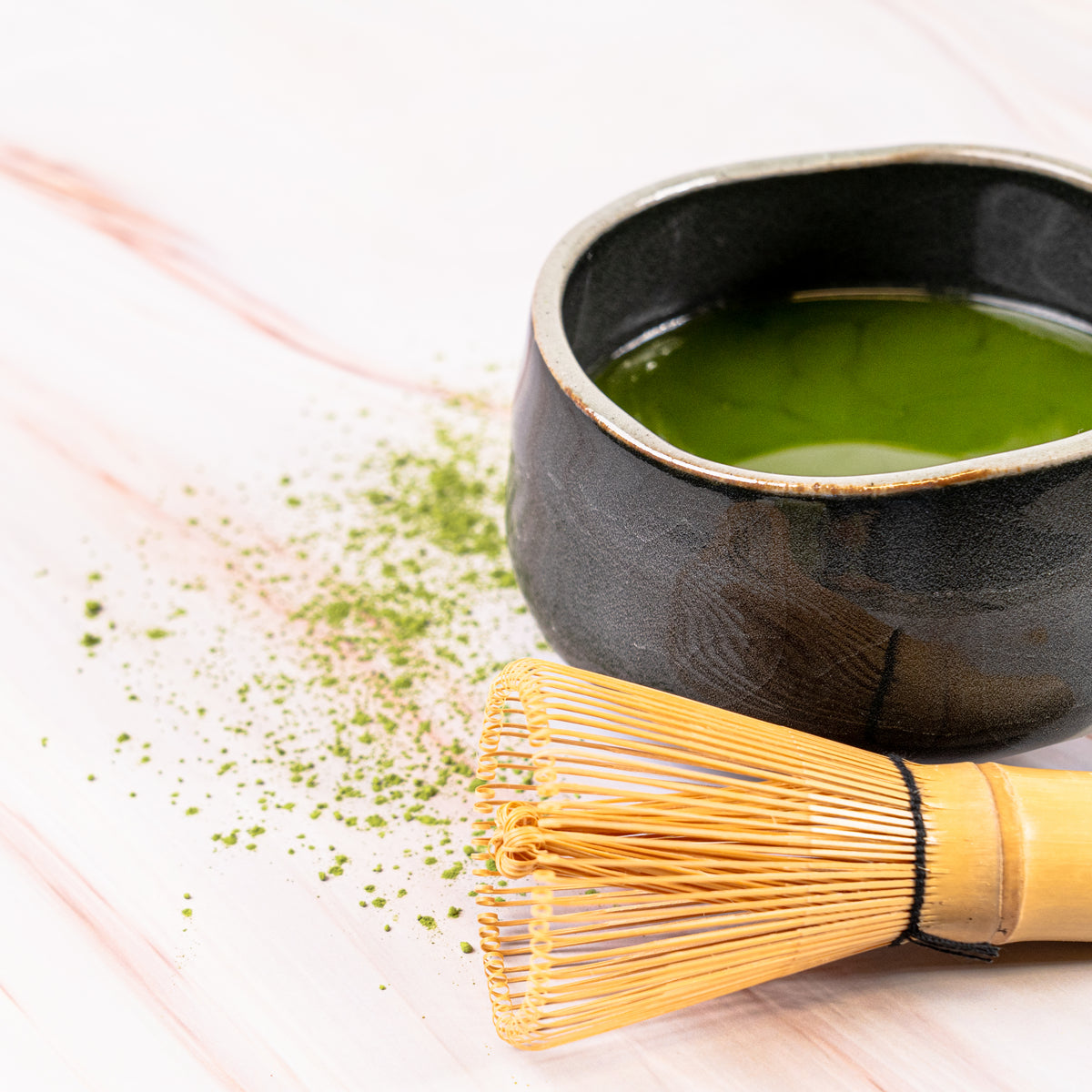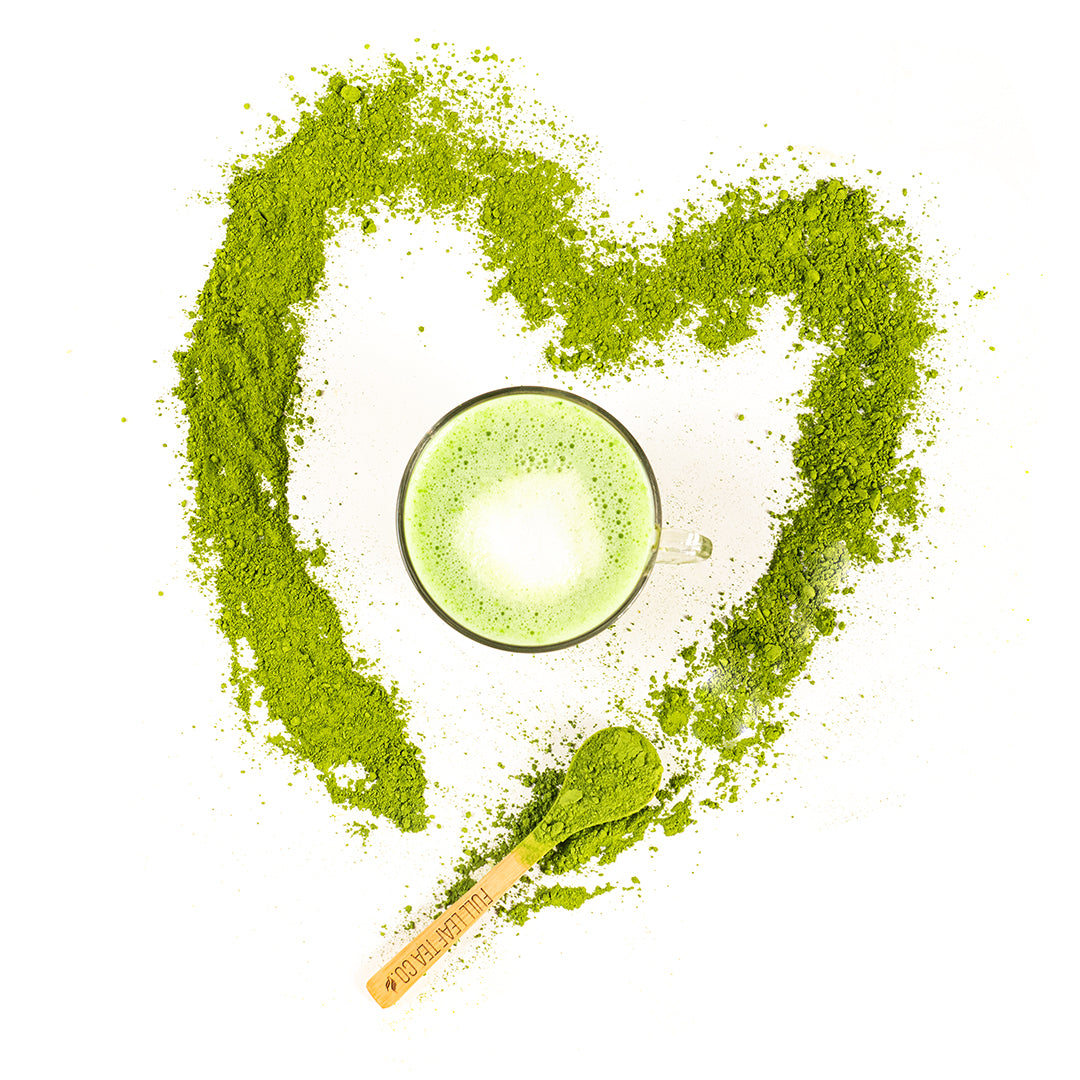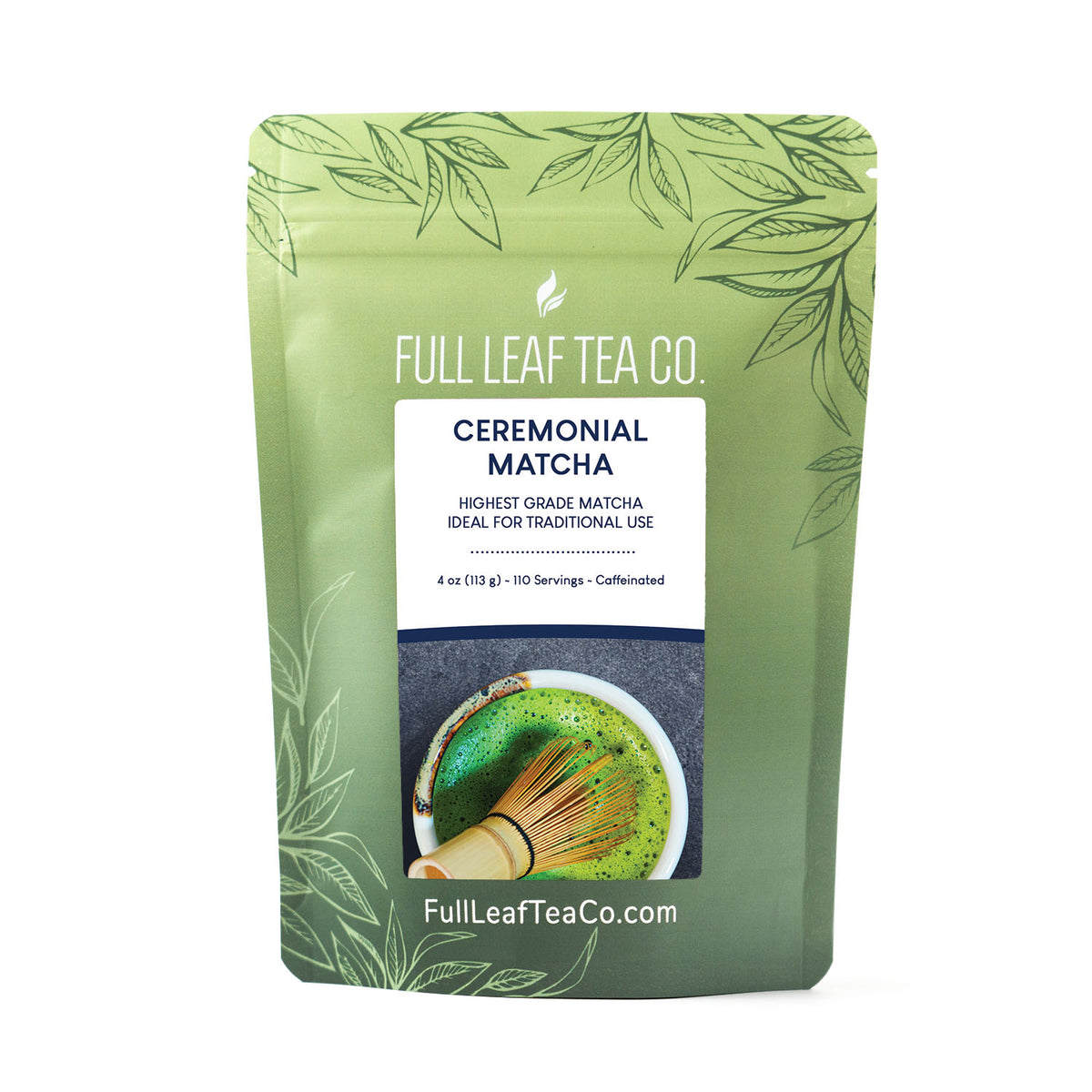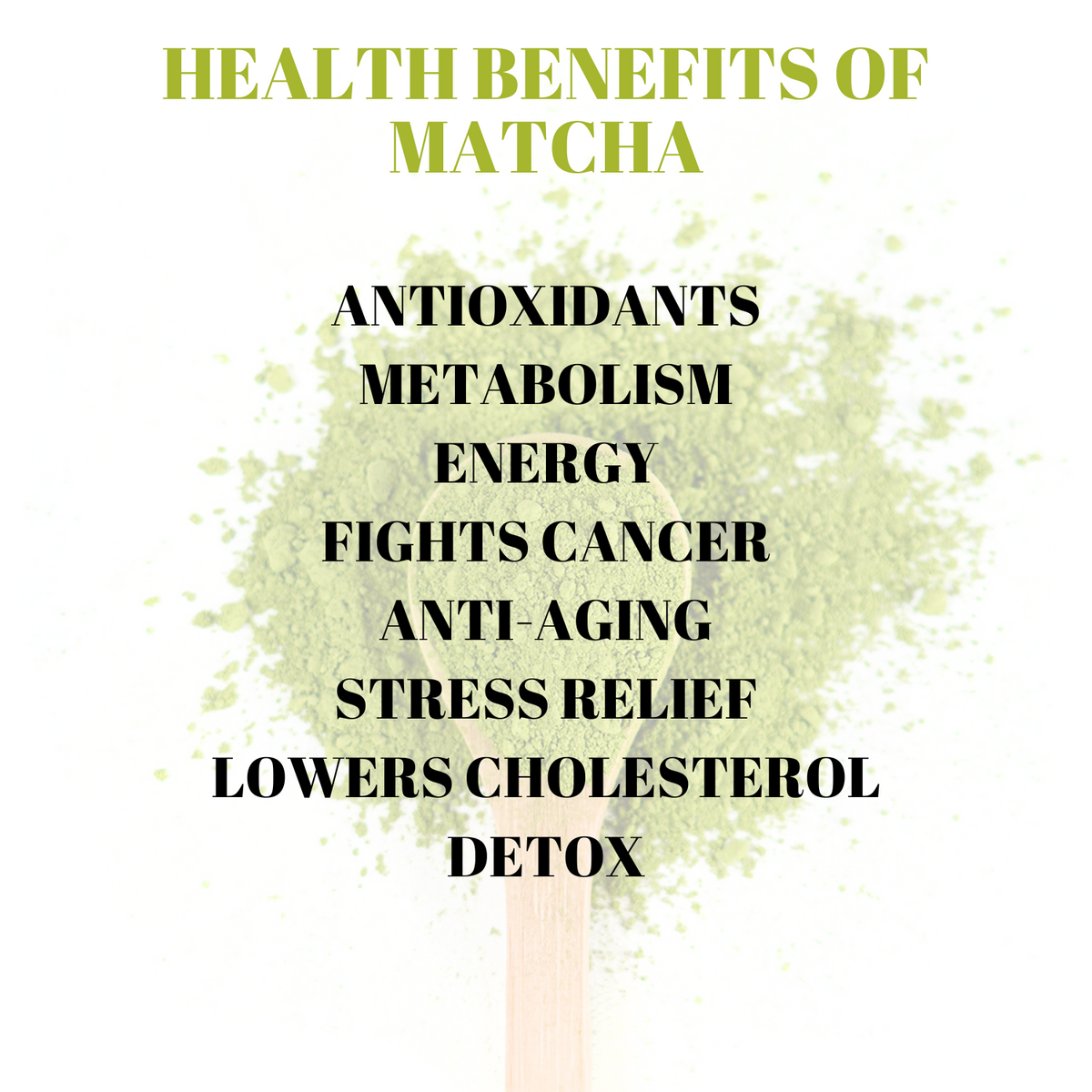Your Complete Guide To Matcha
Introduction to matcha
Matcha (pronounced Ma-cha), is a form of green tea with the exception that as opposed to traditional green tea, you consume the entire powdered Matcha leaf. Matcha comes from the Camelia Sinesis plant, the best of which also comes from Japan.
Matcha in Japan is shade-grown for up to a month to produce the maximum amount of chlorophyll before the leaves stems and veins are removed. The plant is then stone-ground into a very fine powder; this powder is mixed with and dissolved in hot water before consumption.
The shaded growth allows the plant to produce more L-theanine and caffeine than traditionally found in regular green tea. Additionally, by grinding the tea, the consumer enjoys the entire leaf – leading to increased health benefits! Over the past few years, Matcha has seen immense growth and popularity among tea drinkers.
Quickly Jump To:
History of matcha
Matcha dates back to the Tang Dynasty – around 618 - 907, when tea leaves were steamed and formed into bricks for storage. Matcha didn’t start gaining traction in Asia until the Song dynasty, around 960 – 1279, when the powdered tea was used in ritual. In 1191 Matcha was brought to Japan, later becoming an essential staple in monasteries from the 14th to 16th centuries.
In recent times Matcha has become famous for its health properties and uses in smoothies and lattes! When Full Leaf Tea Company started in 2014, Matcha was taking coffee shops, food blogs, and Instagram by storm. Our Matcha has been featured multiple times in magazines, coffee shops, and briefly on the Netflix show ‘Dead to me’ season 1 episode 5.
Currently, the highest grade Matcha comes from Japan – the process Japanese Matcha goes through ensures a top-quality leaf resulting in a naturally organic and better-tasting Matcha. It’s common to see Chinese Matcha retail for less, but unlike Chinese Matcha, Japanese Matcha is free of rice fillers.

Health benefits of matcha
In 2003, a study by the University of Colorado found Matcha contains 137 times as many catechins as traditional green tea. The higher concentration of catechins in Matcha vs. green tea comes from consuming the ground tea leaves versus the steeped tea leaves found in traditional Ceylon green tea. Other nutritional benefits include abundant antioxidants, chlorophyll, and L-Theanine.
What does matcha taste like?
The taste of Matcha itself is frothy and earthy. Great Matcha is very dark green, and it tastes 'green' as well. Matcha on its own is more often an acquired taste for most people, we always recommend starting light and building up as you acquire the taste for Matcha.
If you find you don't enjoy the powdered green tea on its own, try it as a latte! Good Matcha lends to a great cup combined with your favorite milk or milk alternative and a sweetener. Many Matcha companies also sell sweetened Matcha, ours is sweetened with natural organic sugar!
How much caffeine is in matcha?
A question we get a lot on social media and through our E-Mail is "Does Matcha Have Caffeine?" – the answer is yes! Matcha is green tea, which contains caffeine, though because the entire leaf is consumed and not steeped and disposed of, the caffeine content of Matcha is more than traditional green tea.
Compared to coffee, matcha tea's caffeine content is around 24% less - or 70mg of caffeine per 8 ounces of Matcha vs. 96mg of caffeine per 8 ounces of black coffee.
Compared to a shot of espresso, Matcha has 5mg more caffeine in an 8 ounce serving (with a shot of espresso containing 65mg).

Green tea vs. matcha - what's the difference?
With typical green tea, you steep the leaves and then pull them out of the water to drink it. However, with matcha, you are consuming the ground down tea leaves, multiplying the health benefits! Click one of the boxes below to learn more about each difference between Matcha and traditional green tea.
What is the difference between matcha grades?
Ceremonial - Finest Grade

Ceremonial Matcha is the highest grade of Matcha available anywhere. Made from the youngest leaves of the Camelia Sinesis plant, this tea has a beautiful vibrant green and can be easily identified amongst other types of Matcha. Ceremonial Matcha is best consumed as is (hence the name ceremonial).
Ceremonial Matcha →Premium - Second Finest Grade

Premium and Organic Premium are perfect for everyday consumption. If you’re looking to enjoy a matcha latte or even just a cup of matcha daily, we highly recommend premium. Premium grades are typically very high in quality at a more affordable price point.
Organic Premium Matcha →Culinary - Perfect for Baking

Culinary Matcha can still be had as a drink, though its main focus is just that, culinary. Culinary Matcha is made from the older leaves of the Camelia Sinesis plant. These older leaves have larger veins which in turn make the powder more coarse after grinding. Culinary Matcha has a strong and bitter taste that pairs well with other ingredients that might offset it’s lighter counterparts.
Organic Culinary Matcha →Where can I buy matcha powder?
Matcha powder itself can be found online. Shameless plug: but we sell Matcha sourced from the Aichi prefecture in Japan. We’re USDA certified organic, and our products are vegan and free of GMO’s. To top it all off, we have over 10,000 positive reviews, so feel free to try us out! However, if you’re more of an in-store person (we totally get that), you can find Matcha at any organic or wellness store such as Whole Foods.
Shop Our Matcha →How to enjoy your matcha
Now that you know the differences between ceremonial, premium, and culinary matcha, it’s essential to know how to prepare and consume your matcha. We’ve prepared a video on how to prepare your Matcha, which can be found to the right. But in case you would rather read, here is the instructions for making matcha tea!
- Scoop 1/2 tsp of matcha into a bowl (such as a Chawan).
- Add 4 ounces of filtered hot water
- Vigorously whisk in a zig-zag motion until frothy.
- Enjoy your Matcha!
What is a matcha latte?
By now, you’ve probably heard of Matcha Lattes, they’ve been a popular coffee shop item for years due to their taste and health properties. Matcha lattes are simply matcha whisked in a small amount of boiling water, topped off with milk, and sometimes a sweetener.
How do I make a matcha latte?
Crafting a Matcha latte starts with whether you plan on having your drink hot or iced, but they both have the same premise; Matcha, milk, and a sweetener. Matcha lattes are typically made with Premium or Sweetened Premium grades of Matcha rather than Culinary or Ceremonial grades, and they pair well with sweeteners such as cinnamon, agave, or honey. Below we’ve outlined how to craft a hot or iced matcha latte complete with their own videos!
Crafting the perfect hot matcha latte
Hot Matcha Lattes are perfect for cold weather; they’re also the first image that probably pops into your mind when you think of a Matcha latte. We’ve created a brief YouTube video (with timestamps) that goes over what you’ll need, and how to craft a great latte consistently.
- Begin by heating 8 ounces of your choice of milk. We're using Organic, unsweetened Almond milk to let the taste of Matcha shine. Some other great alternatives are Coconut Milk if you prefer something a little sweeter, or Oat Milk if you're looking for something sweeter and thick.
- Once you've heated your milk, grab your milk frother or matcha whisk, and froth your milk until you've achieved your desired foam. Frothing usually takes between 30 seconds to 1 minute.
- Grab your preferred mug or cup and pour 2 teaspoons of your Full Leaf Tea Co. Matcha. Note: Typically, we recommend 1 tsp per 4 ounces of Matcha, but because of the milk to Matcha ratio, you might prefer a more robust mix. Feel free to experiment to your taste.
- Next, add 2 ounces of nearly boiling water to your cup. You'll need to grab your hand frother or matcha whisk and froth until foamy.
- Once your Matcha is frothy, begin slowly pouring your milk into your Matcha in slow, steady circles. The circles ensure a great mix and flavor throughout the drink.
- You're all done! Optionally, feel free to add a sweetener of your choice such as cinnamon, honey, or agave! Experiment and have fun!
Crafting the perfect Hot Matcha Latte
Hot Matcha Lattes are perfect for cold weather; they’re also the first image that probably pops into your mind when you think of a Matcha latte. We’ve created a brief YouTube video (with timestamps) that goes over what you’ll need, and how to craft a great latte consistently.
- Begin by heating 8 ounces of your choice of milk. We're using Organic, unsweetened Almond milk to let the taste of Matcha shine. Some other great alternatives are Coconut Milk if you prefer something a little sweeter, or Oat Milk if you're looking for something sweeter and thick.
- Once you've heated your milk, grab your milk frother or matcha whisk, and froth your milk until you've achieved your desired foam. Frothing usually takes between 30 seconds to 1 minute.
- Grab your preferred mug or cup and pour 2 teaspoons of your Full Leaf Tea Co. Matcha. Note: Typically, we recommend 1 tsp per 4 ounces of Matcha, but because of the milk to Matcha ratio, you might prefer a more robust mix. Feel free to experiment to your taste.
- Next, add 2 ounces of nearly boiling water to your cup. You'll need to grab your hand frother or matcha whisk and froth until foamy.
- Once your Matcha is frothy, begin slowly pouring your milk into your Matcha in slow, steady circles. The circles ensure a great mix and flavor throughout the drink.
- You're all done! Optionally, feel free to add a sweetener of your choice such as cinnamon, honey, or agave! Experiment and have fun!
How to make a delicious iced matcha latte
Iced Matcha Lattes are great for warm weather, they are easier to make (no need to heat and froth milk), and look super pretty! We’ve created a brief YouTube video (with timestamps) that goes over what you’ll need, and how to craft a great iced latte consistently.
- Begin by bringing around 4 ounces of water to a near boil. While you wait, grab your premium or sweetened Matcha, your choice of milk (we’re using Almond milk), and if you’d like, your choice of sweetener.
- Pour 2 teaspoons of your Full Leaf Tea Co. Matcha into a mixing bowl. Note: Typically, we recommend 1 tsp per 4 ounces of Matcha, but because of the milk to Matcha ratio, you might prefer a more robust mix. Feel free to experiment to your taste.
- Pour your hot water into the mixing bowl of Matcha, whisk with your hand frother or matcha whisk and froth until foamy.
- Once your Matcha is frothy, pour your milk into a cup with ice, make sure you leave room for your 4 ounces of Matcha!
- Lastly, slowly pour your Matcha into your cup. Feel free to add a sweetener of your choice such as cinnamon, honey, or agave. Stir with a spoon and you’re done!
How to make a delicious Iced Matcha Latte
Iced Matcha Lattes are great for warm weather, they are easier to make (no need to heat and froth milk), and look super pretty! We’ve created a brief YouTube video (with timestamps) that goes over what you’ll need, and how to craft a great iced latte consistently.
- Begin by bringing around 4 ounces of water to a near boil. While you wait, grab your premium or sweetened Matcha, your choice of milk (we’re using Almond milk), and if you’d like, your choice of sweetener.
- Pour 2 teaspoons of your Full Leaf Tea Co. Matcha into a mixing bowl. Note: Typically, we recommend 1 tsp per 4 ounces of Matcha, but because of the milk to Matcha ratio, you might prefer a more robust mix. Feel free to experiment to your taste.
- Pour your hot water into the mixing bowl of Matcha, whisk with your hand frother or matcha whisk and froth until foamy.
- Once your Matcha is frothy, pour your milk into a cup with ice, make sure you leave room for your 4 ounces of Matcha!
- Lastly, slowly pour your Matcha into your cup. Feel free to add a sweetener of your choice such as cinnamon, honey, or agave. Stir with a spoon and you’re done!
How to make a delicious Iced Matcha Latte
Iced Matcha Lattes are great for warm weather, they are easier to make (no need to heat and froth milk), and look super pretty! We’ve created a brief YouTube video (with timestamps) that goes over what you’ll need, and how to craft a great iced latte consistently.
- Begin by bringing around 4 ounces of water to a near boil. While you wait, grab your premium or sweetened Matcha, your choice of milk (we’re using Almond milk), and if you’d like, your choice of sweetener.
- Pour 2 teaspoons of your Full Leaf Tea Co. Matcha into a mixing bowl. Note: Typically, we recommend 1 tsp per 4 ounces of Matcha, but because of the milk to Matcha ratio, you might prefer a more robust mix. Feel free to experiment to your taste.
- Pour your hot water into the mixing bowl of Matcha, whisk with your hand frother or matcha whisk and froth until foamy.
- Once your Matcha is frothy, pour your milk into a cup with ice, make sure you leave room for your 4 ounces of Matcha!
- Lastly, slowly pour your Matcha into your cup. Feel free to add a sweetener of your choice such as cinnamon, honey, or agave. Stir with a spoon and you’re done!
Is all matcha the same?
Not all matcha is created equal. Some companies appear as if they are offering high grade, pure matcha at a low price. However, they often add rice fillers to their matcha, so you feel like you are getting a lot of product, but you are getting less matcha. Always make sure you check the ingredients!
Where is Full Leaf Tea Companys matcha from?
In order to get the best matcha, location is critical. This is why we choose to source our matcha from the Aichi Prefecture in Japan. Japan is the center of the matcha tradition as they have been making and drinking matcha for centuries.
